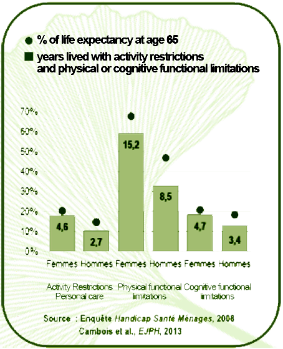Context and objectives
Women’s longevity is an important health issue: although they live longer than men, their additional years of life are mainly years of poor health and disability (Graph). These health situations alter the quality of life and often require extensive care.
In this context, the gender gap raises questions about both its causes and the circumstances in which disabilities are experienced. It appears that these differences are partly due to social determinants that are unequally distributed between men and women, linked to their notoriously different professional, social or family backgrounds. However, the literature provides a rich but fragmented overview of the exposure pathways, along these pathways, to explain the differences in health between women and men.
GINCO develops a holistic approach to gender health differences, based on the database of the CONSTANCES cohort. It will make it possible to construct indicators reflecting the different dimensions of health (from biological functioning to disabilities) that are indicative of gender differences.
The objective is to identify where the differences lie, and then to highlight the exposure pathways that could explain them. We want to identify social determinants at the crossroads of professional, social and family pathways; we assume that there are circumstances (living conditions, occupations, family situation) that can modify these exposure pathways and modulate the health risks. The aim is to explain differences between women and men, but also among women and among men.
Numbers and percentages of years with disability in France, 2008


